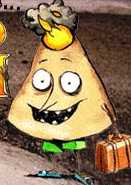| 1.
| What is the Volcano named after? |
| 2.
| Whose is the Ancient Roman's God of Fire? |
| 3.
| Tell the story of Vulcan in your own words. |
| 4.
| Where did the Roman's believe the smoke and fire from a volcano came from? |
| 5.
| Scroll back to the top and open Structure of a Volcano from the left column. |
| 6.
| Draw a rough diagram of the structure of a volcano. |
| 7.
| A volcano has four parts. State these parts and define each. |
| 8.
| Scroll up and open Types of Volcanoes from the left column | |
| 9.
| What are the characteristics used when classifying volcanoes? |
| 10.
| There are 5 types of Volcanoes. What are they? |
| 11.
| How are composite volcanoes formed? |
| 12.
| Composite volcanoes are usually explosive eruptions. Why? |
| 13.
| What are some of the strato-volcanoes that have occurred in the past? |
| 14.
| How are shield volcanoes built? |
| 15.
| How are cinder cones built? |
| 16.
| How is the shape of cinder cones modified? |
| 17.
| Scroll up and open How a Volcano Erupts from the left column | |
| 18.
| Why do eruptions begin and what is conduit? |
| 19.
| There are 4 eruption scenarios. Describe each and what are the causes of each. |
| 20.
| Define and explain the 6 types of material that fall from the volcanic eruptions. |
| 21.
| Scroll up and open Hot Spots from the left column. | |
| 22.
| What exactly are hot spots and what popular vacation spots were built from them? |
| 23.
| What happens when a hot spot forms under a continental plate? |
| 24.
| How big are the flood basalts in the Columbia Plateau and what do we compare this to in size? |
| 25.
| Scroll up and open Types of Eruptions. Read the page. | |
| 26.
| Scroll up and open Volcanic Features from the left column. | |
| 27.
| Are calderas formed as a result of every volcanic eruption? |
| 28.
| What is cauldron subsidence? |
| 29.
| Scroll up and open Effect of Eruptions from the left-hand column. | |
| 30.
| Distinguish the difference between Pahoehoe and AA lava. |
| 31.
| Scroll up and open Prediction of Danger from the left-hand column. | |
| 32.
| List and describe the three methods and instruments used in predicting volcanic eruptions. |
| 33.
| Scroll up and open Advantages of Volcanoes from the left-hand column. | |
| 34.
| Are there any advantages of volcanoes? If so, what are some of them? |
| 35.
| Scroll up and open Gold beneath the sea from the left-hand column. | |
| 36.
| What is theory about black smokers that is circulating through science today? |
| 37.
| Attach the answers to your questions to the back of the paper and turn in. |
 Volcanoes
Volcanoes
 Volcanoes
Volcanoes